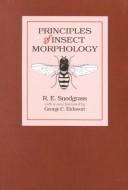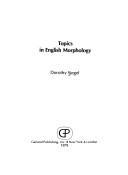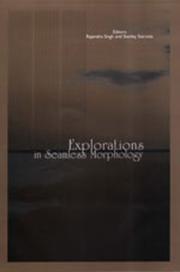| Listing 1 - 10 of 703 | << page >> |
Sort by
|
Book
ISBN: 0710072465 Year: 1972 Publisher: London,Boston : Routledge and K. Paul,
Abstract | Keywords | Export | Availability | Bookmark
 Loading...
Loading...Choose an application
- Reference Manager
- EndNote
- RefWorks (Direct export to RefWorks)
Morphology --- Philosophy

ISBN: 150171791X 9781501717918 0801428831 9780801428838 0801481252 9780801481253 Year: 2018 Publisher: Ithaca, NY : Cornell University Press,
Abstract | Keywords | Export | Availability | Bookmark
 Loading...
Loading...Choose an application
- Reference Manager
- EndNote
- RefWorks (Direct export to RefWorks)
This classic text, first published in 1935, is once again available. Still the standard reference in the English language, Principles of Insect Morphology is considered the author's masterpiece. A talented artist as well as one of the leading entomologists of his day, Robert E. Snodgrass produced a wealth of publications that display an accuracy and precision still unsurpassed.The 19 chapters in this volume cover each group of insect organs and their associated structures, at the same time providing a coherent morphological view of their fundamental nature and apparent evolution. To accomplish this aim, Snodgrass compares insect organs with those of other arthropods. Each chapter concludes with a glossary of terms. The 319 multipart illustrations are an invaluable source of information and have never been duplicated.This edition includes a new foreword by George Eickwort, Professor of Entomology at Cornell University, which relates the book to today's courses in insect morphology. Republication of this textbook will provide another generation of students with an essential foundation for their studies in entomology.
Insects --- Anatomy. --- Morphology. --- Morphology --- Anatomy

ISBN: 0824096754 Year: 1979 Publisher: New York (N.Y.) Garland
Abstract | Keywords | Export | Availability | Bookmark
 Loading...
Loading...Choose an application
- Reference Manager
- EndNote
- RefWorks (Direct export to RefWorks)
English language --- -Germanic languages --- Morphology --- Theses --- Morphology. --- -Morphology --- Germanic languages

ISBN: 1282154133 9786612154133 8132102843 9788132102847 9781282154131 6612154136 0761995943 9780761995944 8178292238 9788178292236 Year: 2003 Publisher: New Delhi Thousand Oaks, Calif. Sage Publications
Abstract | Keywords | Export | Availability | Bookmark
 Loading...
Loading...Choose an application
- Reference Manager
- EndNote
- RefWorks (Direct export to RefWorks)
This volume exposes the inadequacies of morpheme or stem based theories of morphology and introduces the two versions (the Montreal version, called Whole Word Morphology, and the `lexicase` one) of a radically a-morphous morphology, somewhat mischievously designated, by Starosta, as `seamless morphology`. It also makes clear their many shared assumptions and principles as well as the differences between them. A number of contributors deal with `compounding` and `incorporation`, two of the toughest problems in maintaining the seamless position. Other contributions show the advantages of that po
Grammar, Comparative and general --- Morphology (Linguistics) --- Morphology. --- Linguistics --- Philology --- Grammar, Comparative and general Morphology --- Morphology
Book
ISBN: 1628089822 9781628089820 9781628083989 1628083980 Year: 2013 Publisher: New York
Abstract | Keywords | Export | Availability | Bookmark
 Loading...
Loading...Choose an application
- Reference Manager
- EndNote
- RefWorks (Direct export to RefWorks)
Are words really so determined by rules that, as Leonard Bloomfield once argued in defense of the ""morpheme-based"" morphology, ""word forms are analyzed as arrangements of morphemes,"" such that there are ""rules to combine morphemes into word forms, or to generate word forms from stems...""? (WK 2012) But there is an opposing approach to morphology known as the ""word-based"" morphology, which ""takes paradigms as a central notion,"" in that it ""states generalizations"" which categorize ""words...based on the pattern they fit into. This applies both to existing words and to new ones. Appli
Grammar, Comparative and general --- Morphology (Linguistics) --- Morphology. --- Linguistics --- Philology --- Grammar, Comparative and general Morphology --- Morphology
Book
ISBN: 8024629186 9788024629186 9788024628813 8024628813 Year: 2016 Publisher: Prague
Abstract | Keywords | Export | Availability | Bookmark
 Loading...
Loading...Choose an application
- Reference Manager
- EndNote
- RefWorks (Direct export to RefWorks)
Grammar, Comparative and general --- Morphology (Linguistics) --- Morphology. --- Linguistics --- Philology --- Grammar, Comparative and general Morphology --- Morphology
Book
ISBN: 9781474436168 9781474436151 9781474436175 9781474436182 147443617X 1474436161 1474436153 1474436188 Year: 2019 Publisher: Edinburgh Edinburgh University Press
Abstract | Keywords | Export | Availability | Bookmark
 Loading...
Loading...Choose an application
- Reference Manager
- EndNote
- RefWorks (Direct export to RefWorks)
An accessible and critical overview of the core issues in morphologyDifferent theoretical positions can lead to conflicting restrictions on our understanding of what morphology is about. In this textbook, Laurie Bauer presents a new way of thinking about morphological structure – one that will maximise our benefits from the existing disparate approaches available. Presenting a clear and critical overview, this book equips students with the tools to discuss morphological phenomena and to do so in relation to other linguistic contexts, including semantics, psycholinguistics and language change.Structured around the core areas of morphemic theory, word morphology, word syntax, the boundaries of morphology, and exemplars and resonances, each chapter discusses the limits, strengths and wider implications of existing theories and issues surrounding these facets of morphology.Rethinking Morphology:Presents a critical overview of the core issues of morphologyPlaces morphology into modern cognitive perspectivesEncourages readers to critically engage with morphological theory Includes discussion questions and suggestions for further readingProvides sample answers to discussion questions on the resources tab Is suitable for students interested in applying morphological materials to other areas, for example historical, psycholinguistic and sociolinguistic studies
Grammar --- Grammar, Comparative and general --- Morphology (Linguistics) --- Morphology --- Morphology. --- Linguistics --- Philology --- Grammar, Comparative and general Morphology
Book
ISBN: 9781108045056 1108045057 113917729X 9781139177290 Year: 2012 Publisher: Cambridge Cambridge University Press
Abstract | Keywords | Export | Availability | Bookmark
 Loading...
Loading...Choose an application
- Reference Manager
- EndNote
- RefWorks (Direct export to RefWorks)
When she was elected a Fellow of the Royal Society in 1946, Agnes Arber was one of only three women to have been admitted into the institution. Arber conducted research that focused mainly on the morphology of flowering plants, but her work is characterised by its explorations of historical botany & evoluiton. This book widens the scope of morphology into a study of all aspects of form across the whole chronology of botany. Arber begins with Aristotle & investigates the work of early modern botanists like Bacon & Goethe, before examining the effects of this wider approach on subjects like evolution & taxonomy. Arguing that post-Darwinian doctrine often causes botanists to twist their observations to suit a hypothetical history of phylogenesis, rather than changing the hypothesis to suit observational facts, this bold & fascinating text will interest students of biology & philosophy alike.
Plant morphology. --- Botany --- Philosophy. --- Morphology (Plants) --- Plants --- Morphology --- Plantes --- Morphologie. --- Plant morphology
Book
ISBN: 9781108810319 9781108893886 Year: 2021 Publisher: Cambridge Cambridge University Press
Abstract | Keywords | Export | Availability | Bookmark
 Loading...
Loading...Choose an application
- Reference Manager
- EndNote
- RefWorks (Direct export to RefWorks)
Book
ISBN: 1283231689 9786613231680 9048504996 9789048504992 9789087280277 Year: 2007 Publisher: Amsterdam Leiden University Press
Abstract | Keywords | Export | Availability | Bookmark
 Loading...
Loading...Choose an application
- Reference Manager
- EndNote
- RefWorks (Direct export to RefWorks)
Caecilians, or Gymnophiona, constitute one of the three extant orders of the Recent Amphibia and comprise about 170 named species in six families. They are the least known, major living tetrapod clade. Compared to frogs and salamanders, caecilians have an unusual skull morphology. With few exceptions, previous studies on caecilian morphology have been restricted to investigations on adult material and were usually carried out on small samples. This thesis investigates skull development in caecilians. Earlier reports of an unusually high number of individual skull ossifications in Hypogeophis r
Caecilians --- Morphology. --- Anatomy.
| Listing 1 - 10 of 703 | << page >> |
Sort by
|

 Search
Search Feedback
Feedback About UniCat
About UniCat  Help
Help News
News